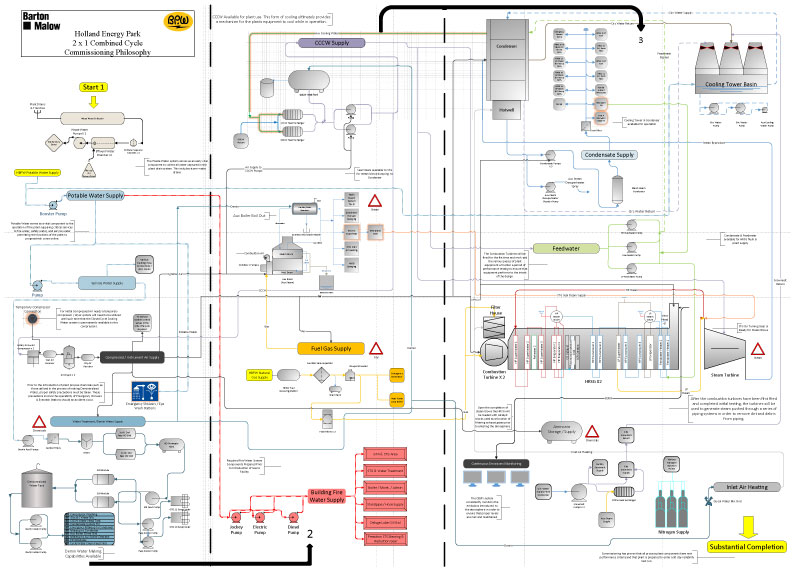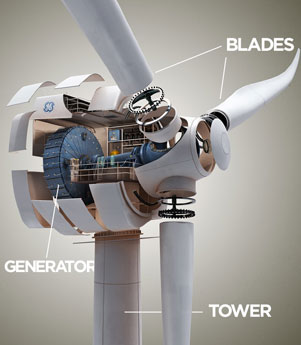Technology Introduction
We’re dedicated to producing energy in the most socially, economic and environmental ways we can. On 11/12/2012 the City of Holland voted to approve our recommendations to construct a new, state-of-the-art combined-cycle natural gas power plant. We are still in the early stages of the project, but check our news blog periodically to stay up-to-date with the latest information on the project.
Our customers are sometimes surprised to hear how invested we are in a diverse array of power generation options. In fact, with our Power Purchase Agreements (PPAs), over 16% of our power comes from atypical energy sources like wind, biomass, and landfill gas, significantly more than the state required amount of 10%.
What’s a Power Purchase Agreement (PPA)?
Power purchase agreements are federally regulated contracts between two power production entities. The Holland BPW engages in several power agreements that allows us to invest and purchase power from alternative energy sources across the “grid” without having to build the infrastructure for it on our own land.
How does our current power plant work?
For our 2011 Annual Report, we produced a field guide to explain the power process. Check it out to learn more about our current generation process.
How did we decide on these options for powering Holland?
Our recommendations for Holland’s future power are the result of a two-year long study that involved an SROI, community input and consulting from other experts. Our 2012 Annual Report does a great job of explaining the SROI. Check it out here.
Explore some of the diverse power options we’re involved in.
Natural Gas
What is Combined-Cycle Natural Gas?
In a Combined-Cycle Natural Gas (CCNG) system, two turbines work in tandem to generate electricity. The first—in this case, a natural gas turbine—generates electricity, and exhaust heat from that combustion is used to turn a second turbine, which is typically a steam turbine. This reuse of excess heat provides much more efficient generation than is provided by a natural gas turbine alone. (Video courtesy of Siemens AG)
What are the benefits of natural gas?
- Natural gas is reliable, available and sourced in the United States.
- Natural gas is one of the most cost-effective fuel sources available on the market today.
- Natural gas is significantly more efficient, which makes it much more environmentally friendly than coal. It produces an average of 50% less CO2, lower levels of NOx, fewer particulate emissions, and virtually no SO2 and mercury emissions.
 How Does it Work?
How Does it Work?
If you’re up for an interactive experience, visit an entry from the 2014 Annual Report to experience how all the components of a combined cycle system work together. For a more technical experience, dive deep into our commissioning diagram.
Wind Turbines
 We use wind energy in Holland?
We use wind energy in Holland?
The Holland BPW has Power Purchase Agreements (PPAs) with two wind-energy arrays:
- A 16.8 MW array in Ithaca, MI
- A 15 MW array in Elwood, IN.
How does wind energy work?
Most wind-based power generation setups involve an array of wind turbines (like the one pictured here) built in an area with consistent, year-round wind. Wind drives the turbine’s propeller-like blades, which in turn drive the electric generator inside. Power is then transferred down the shaft to a transformer at the base, where power is converted to be integrated into the grid.
What are the benefits of wind energy?
Although wind power is intermittent (when the wind’s now blowing, they don’t contribute to the grid), it can be an excellent supplement to base load energy production.
Wind energy, after the turbine is manufactured, produces no carbon emissions and has a very small ecological footprint, which makes it one of the most environmentally friendly energy sources.
Landfill Gas Power
We use landfill gas to power Holland?
Since early 2010, the Holland BPW has contracted in PPAs with landfill gas power plants from Granger and North American Natural Resources (NANR), which together produce over 5.1 MW of energy and should increase to 9.8 MW by 2018.
What is landfill gas power?
With hundreds of millions of tons of garbage going into landfills every year in the United States, waste can breakdown to produce an enormous amount of volatile gases, especially methane. Without safe ways of venting or repurposing this gas, methane buildups can cause dangerous explosions.
A great way to solve this problem is to use the gas to produce electricity. Landfill gas power plants drill into landfills to release gases and safely burn methane to drive turbines.
